
Shareholder Letter Q4 2020
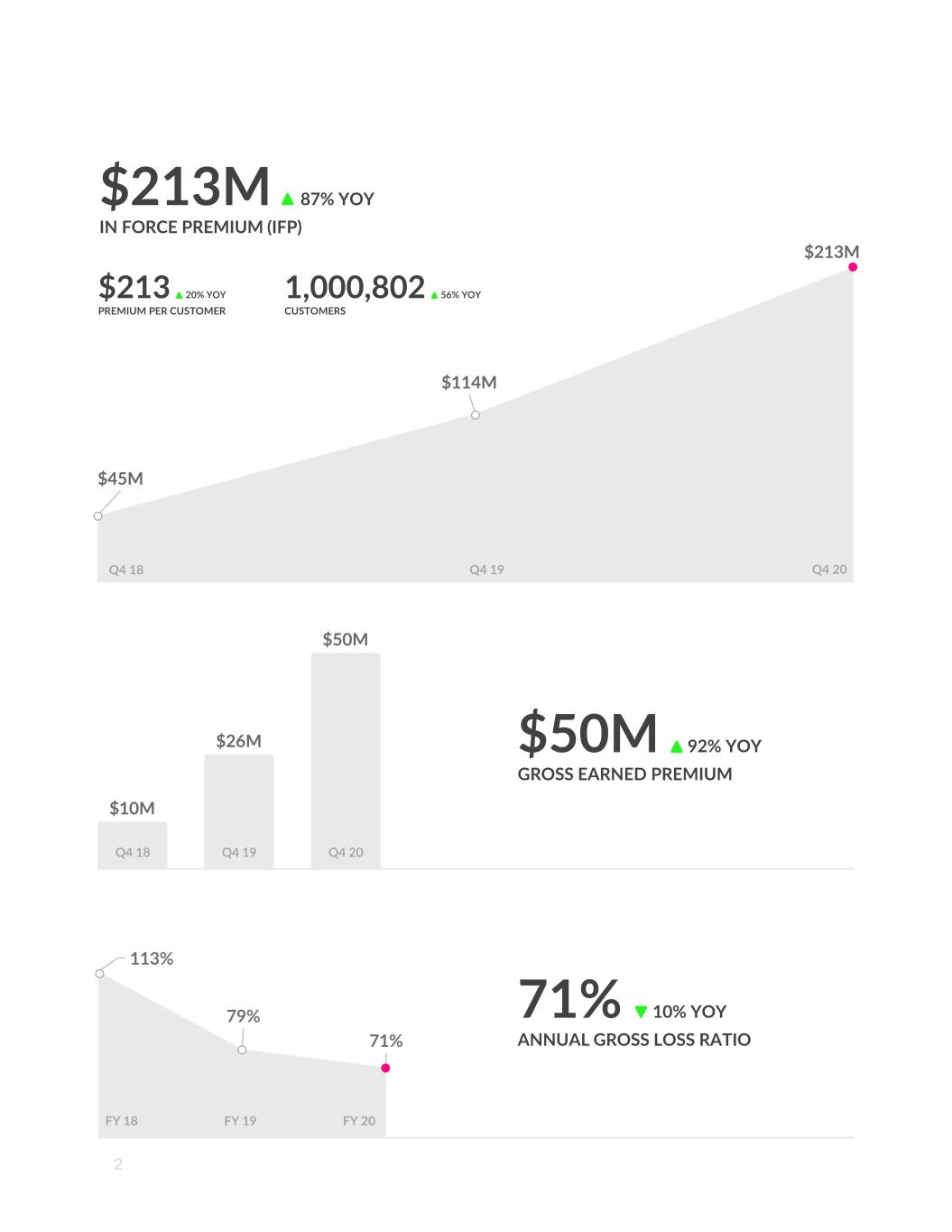
$50M 92% YOY GROSS EARNED PREMIUM Q4 18 Q4 19 Q4 20 Q4 18 Q4 19 Q4 20 113% 79% 71% 71% 10% YOY ANNUAL GROSS LOSS RATIO FY 18 FY 19 FY 20 $213 20% YOY PREMIUM PER CUSTOMER 1,000,802 56% YOY CUSTOMERS $213M 87% YOY IN FORCE PREMIUM (IFP) 2
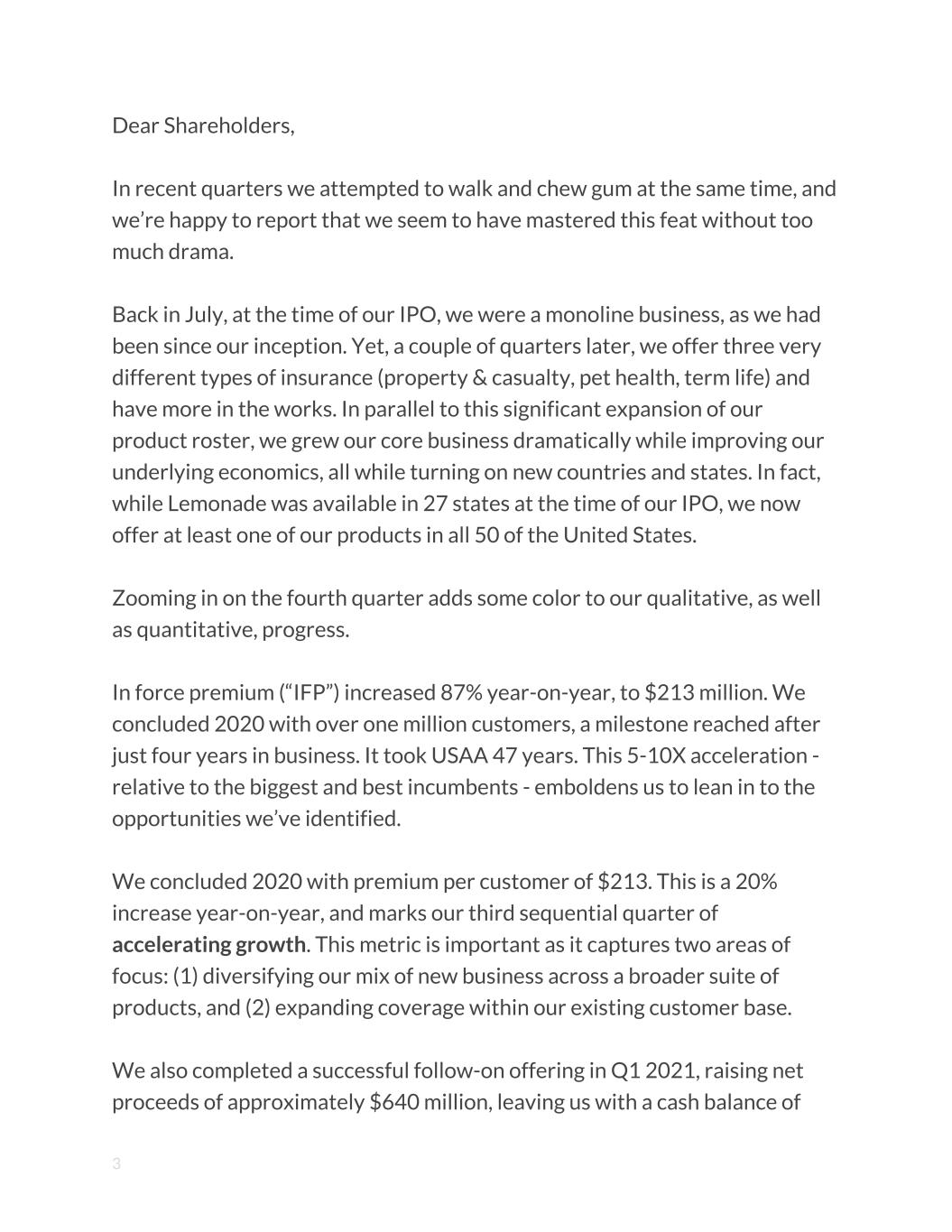
Dear Shareholders, In recent quarters we attempted to walk and chew gum at the same time, and we’re happy to report that we seem to have mastered this feat without too much drama. Back in July, at the time of our IPO, we were a monoline business, as we had been since our inception. Yet, a couple of quarters later, we offer three very different types of insurance (property & casualty, pet health, term life) and have more in the works. In parallel to this significant expansion of our product roster, we grew our core business dramatically while improving our underlying economics, all while turning on new countries and states. In fact, while Lemonade was available in 27 states at the time of our IPO, we now offer at least one of our products in all 50 of the United States. Zooming in on the fourth quarter adds some color to our qualitative, as well as quantitative, progress. In force premium (“IFP”) increased 87% year-on-year, to $213 million. We concluded 2020 with over one million customers, a milestone reached after just four years in business. It took USAA 47 years. This 5-10X acceleration - relative to the biggest and best incumbents - emboldens us to lean in to the opportunities we’ve identified. We concluded 2020 with premium per customer of $213. This is a 20% increase year-on-year, and marks our third sequential quarter of accelerating growth. This metric is important as it captures two areas of focus: (1) diversifying our mix of new business across a broader suite of products, and (2) expanding coverage within our existing customer base. We also completed a successful follow-on offering in Q1 2021, raising net proceeds of approximately $640 million, leaving us with a cash balance of 3
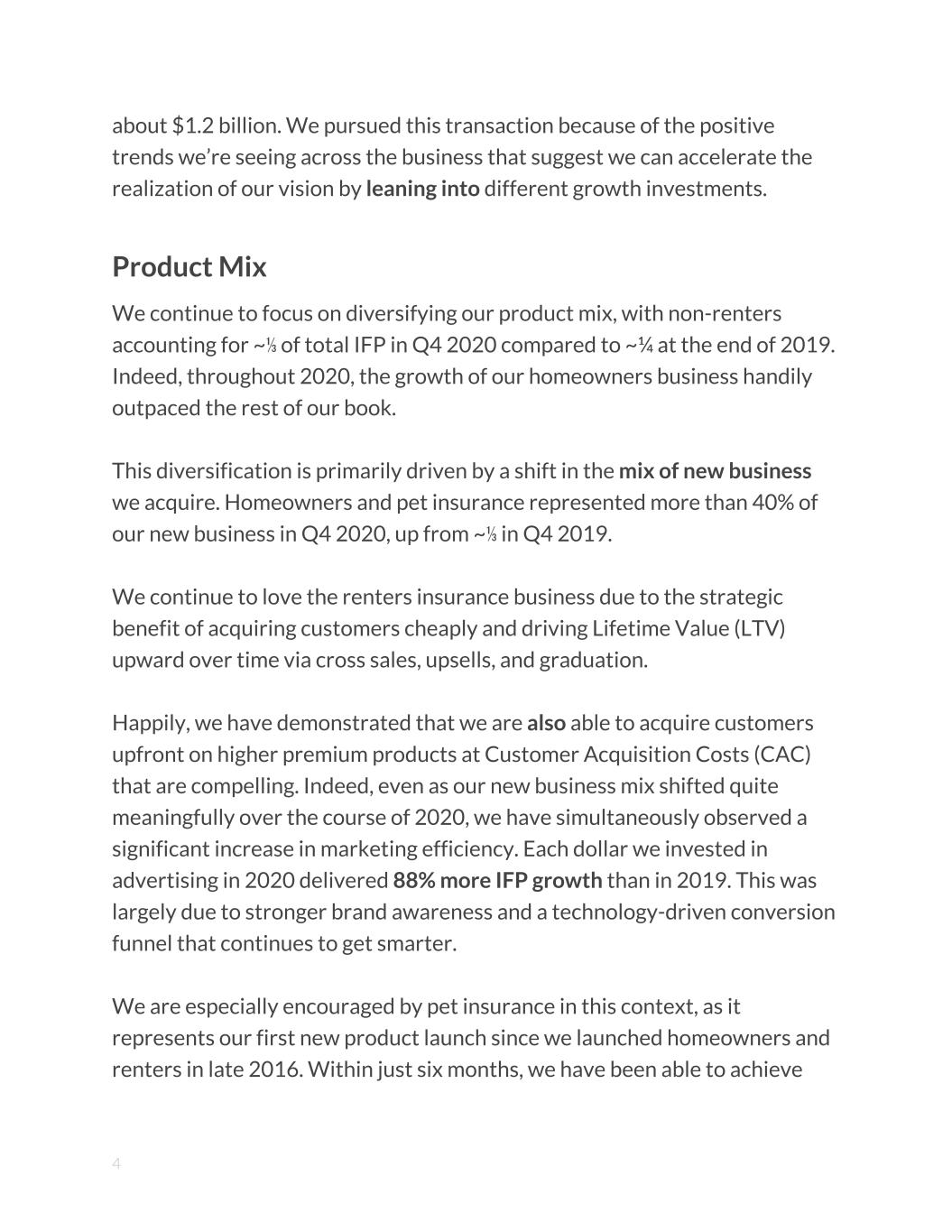
about $1.2 billion. We pursued this transaction because of the positive trends we’re seeing across the business that suggest we can accelerate the realization of our vision by leaning into different growth investments. Product Mix We continue to focus on diversifying our product mix, with non-renters accounting for ~⅓ of total IFP in Q4 2020 compared to ~¼ at the end of 2019. Indeed, throughout 2020, the growth of our homeowners business handily outpaced the rest of our book. This diversification is primarily driven by a shift in the mix of new business we acquire. Homeowners and pet insurance represented more than 40% of our new business in Q4 2020, up from ~⅓ in Q4 2019. We continue to love the renters insurance business due to the strategic benefit of acquiring customers cheaply and driving Lifetime Value (LTV) upward over time via cross sales, upsells, and graduation. Happily, we have demonstrated that we are also able to acquire customers upfront on higher premium products at Customer Acquisition Costs (CAC) that are compelling. Indeed, even as our new business mix shifted quite meaningfully over the course of 2020, we have simultaneously observed a significant increase in marketing efficiency. Each dollar we invested in advertising in 2020 delivered 88% more IFP growth than in 2019. This was largely due to stronger brand awareness and a technology-driven conversion funnel that continues to get smarter. We are especially encouraged by pet insurance in this context, as it represents our first new product launch since we launched homeowners and renters in late 2016. Within just six months, we have been able to achieve 4

marketing efficiency levels at parity with the broader book of business - levels that took us years to achieve for our home products. Our term life product wasn’t live in Q4 2020, and so isn’t reflected in today’s results, but early indications are encouraging. All told, we’re increasingly confident in our ability to launch additional new products that quickly contribute to new customer acquisition and to our overall economics. Additional Policy Purchases: Lifetime Value & Dollar Retention In Q4 2020, we once again saw robust growth in ‘graduation’ - that is, renters becoming homeowners and increasing their premiums ~6X - of about 250% year-on-year, significantly outpacing the growth of our overall book of business. Graduation is just one instance of customers growing with Lemonade, and we are seeing a meaningful increase in cross sales across our book. Albeit starting from a modest base in Q3, our Q4 2020 sequential growth rate of customers with multiple policies outpaced growth of single-policy customers by 5X. This suggests that one of the company’s core strategies is playing out: by delivering a best-in-class experience to customers at every stage, we are able to drive coverage expansion over time. Roughly 50% of IFP attributable to our pet product at year-end was generated by cross sales to existing customers. A cross sale to pet insurance generates a 4X median increase in a customer’s premium, driving very compelling LTV to CAC ratios - given that these additional policies effectively have a CAC of zero. As we gather more data on cross selling behavior, we will begin to target segments of users who are more likely to purchase multiple 5

policies with us. These users can become very profitable even at higher levels of CAC, allowing us to further accelerate growth. While it is early days, we have also seen similar cross selling dynamics for term life insurance, with cross sales accounting for almost half of the total life business we have generated so far. In addition to improving LTV/CAC ratios, cross sales impact our dollar retention rates. In Q4 2020, additional policy purchases by existing Lemonade customers (largely cross sales and graduation sales) improved our annual dollar retention rate by about 10%. Loss Ratio For the full year 2020, our gross loss ratio was 71%, as compared to 79% in 2019. Our fourth quarter gross loss ratio was 73%, little changed from the 72% in Q3 2020 and 73% in Q4 2019. This apparent stability in our Q4 loss ratio - both year-on-year and quarter-on-quarter - masks some noteworthy undercurrents. In prior periods, our total loss ratio was consistent with our US home products loss ratio. Throughout Q4, an increasing percentage of our premiums and claims came from new products and new geographies, a trend that is set to continue. This shift is important. The loss ratio of customers in the first year of their policy is typically higher than that of subsequent years, a phenomena known as the ‘new business penalty.’ For example, at Lemonade we see a 15-20% higher loss ratio for year one renters as compared to year two. 6
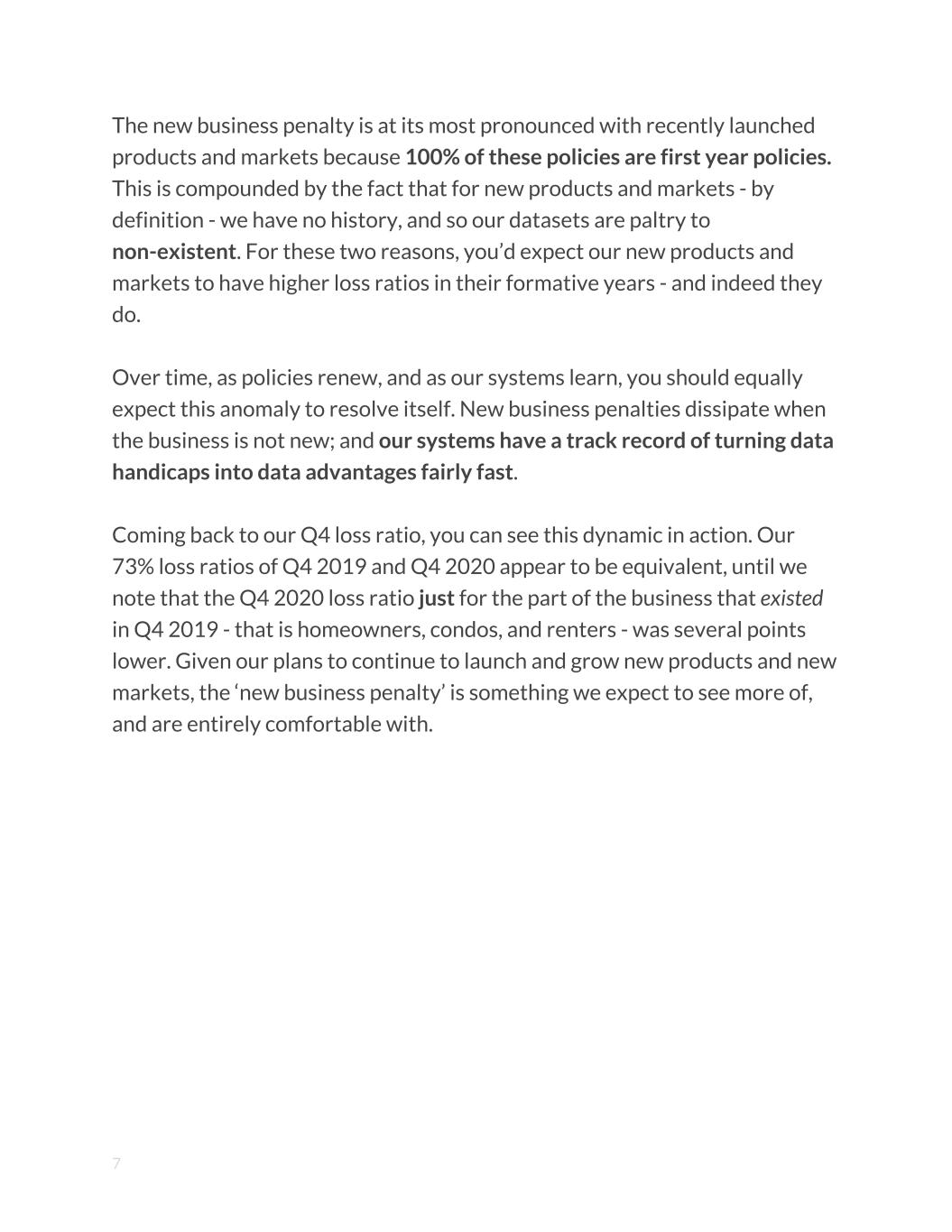
The new business penalty is at its most pronounced with recently launched products and markets because 100% of these policies are first year policies. This is compounded by the fact that for new products and markets - by definition - we have no history, and so our datasets are paltry to non-existent. For these two reasons, you’d expect our new products and markets to have higher loss ratios in their formative years - and indeed they do. Over time, as policies renew, and as our systems learn, you should equally expect this anomaly to resolve itself. New business penalties dissipate when the business is not new; and our systems have a track record of turning data handicaps into data advantages fairly fast. Coming back to our Q4 loss ratio, you can see this dynamic in action. Our 73% loss ratios of Q4 2019 and Q4 2020 appear to be equivalent, until we note that the Q4 2020 loss ratio just for the part of the business that existed in Q4 2019 - that is homeowners, condos, and renters - was several points lower. Given our plans to continue to launch and grow new products and new markets, the ‘new business penalty’ is something we expect to see more of, and are entirely comfortable with. 7

Q4 2020 Results, KPIs and Non-GAAP Financial Measures In Force Premium (IFP) IFP, defined as the aggregate annualized premium for customers as of the period end date, increased by 87% to $213.0 million as compared to the fourth quarter of 2019, primarily due to a 56% increase in the number of customers as well as a 20% increase in premium per customer. Customers Customer count increased by 56% to 1,000,802 as compared to the fourth quarter of 2019. Premium per Customer Premium per customer, defined as in force premium divided by customers, was $213 at the end of the fourth quarter, up 20% from the fourth quarter of 2019. This is primarily due to the continued shift of our business mix toward products with higher average policy values, an increasing prevalence of multiple policies per customer, as well as growth in the overall average policy value and pricing impact. Gross Earned Premium Fourth quarter gross earned premium of $50.0 million increased by $24.0 million or 92% as compared to the fourth quarter of 2019, primarily due to the increase of in force premium earned during the quarter. 8

Revenue Fourth quarter total revenue was $20.5 million. Note that our ‘proportional reinsurance’ agreements went into effect at the beginning of the third quarter, increasing the proportion of premium that is ceded to 75%. This meaningfully improves the capital efficiency of our business, but can make year-on-year comparisons of revenue misleading. Gross Profit Fourth quarter gross profit of $7.5 million increased $2.7 million, or 56% as compared to the fourth quarter of 2019, primarily due to the increase in gross earned premium, partially offset by the lower effective interest rate impact on investment income. Adjusted Gross Profit Fourth quarter adjusted gross profit of $9.5 million increased $4.4 million or 86% as compared to the fourth quarter of 2019, primarily due to the increase in gross earned premium. Adjusted gross profit is a non-GAAP metric. Reconciliations of GAAP to non-GAAP financial measures, as well as definitions for the non-GAAP financial measures included in this letter and the reasons for their use, are presented at the end of this letter. Operating Expense Total operating expense, excluding net loss and loss adjustment expense, in Q4 increased 10% to $44.6 million as compared to the $40.5 million in the fourth quarter of 2019, driven primarily by increases in other insurance 9
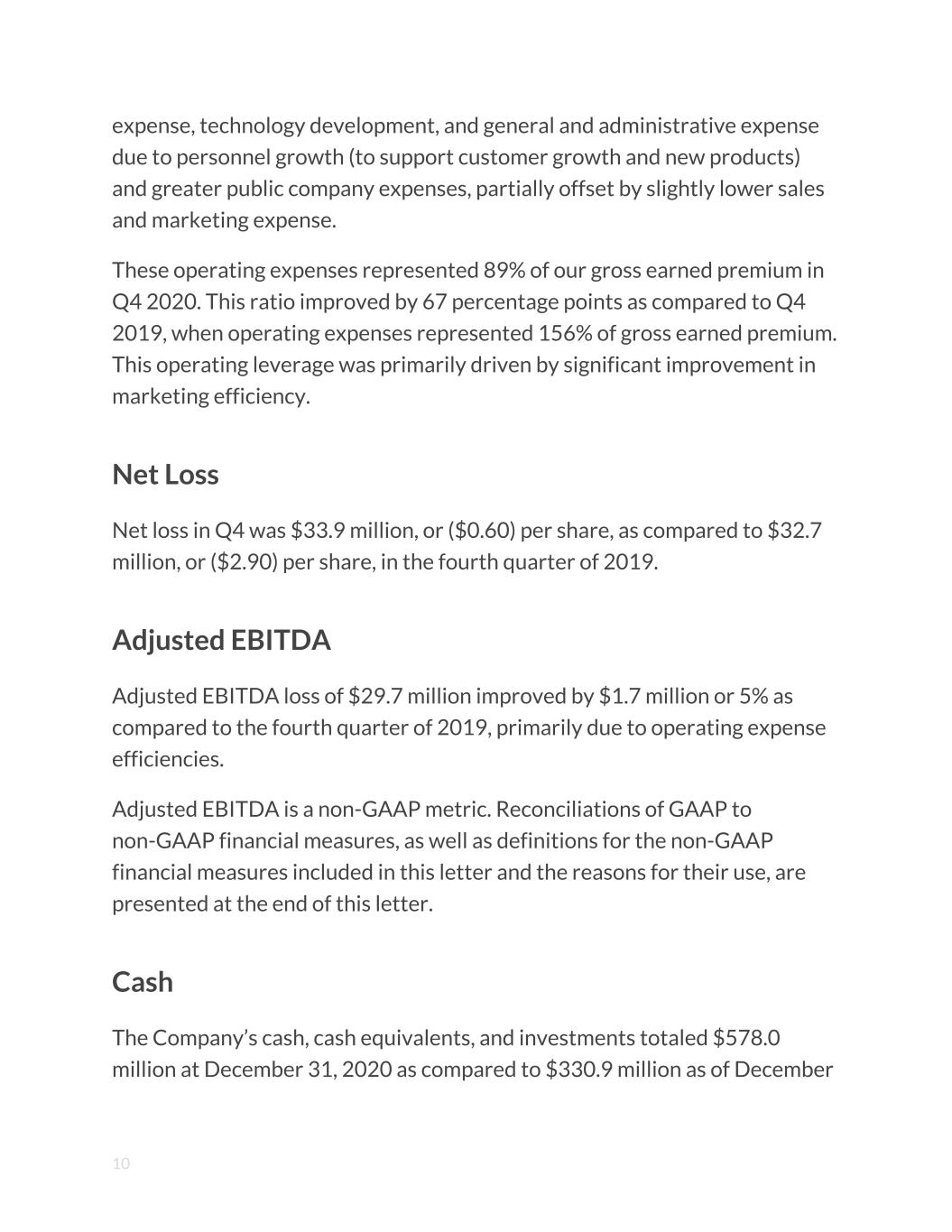
expense, technology development, and general and administrative expense due to personnel growth (to support customer growth and new products) and greater public company expenses, partially offset by slightly lower sales and marketing expense. These operating expenses represented 89% of our gross earned premium in Q4 2020. This ratio improved by 67 percentage points as compared to Q4 2019, when operating expenses represented 156% of gross earned premium. This operating leverage was primarily driven by significant improvement in marketing efficiency. Net Loss Net loss in Q4 was $33.9 million, or ($0.60) per share, as compared to $32.7 million, or ($2.90) per share, in the fourth quarter of 2019. Adjusted EBITDA Adjusted EBITDA loss of $29.7 million improved by $1.7 million or 5% as compared to the fourth quarter of 2019, primarily due to operating expense efficiencies. Adjusted EBITDA is a non-GAAP metric. Reconciliations of GAAP to non-GAAP financial measures, as well as definitions for the non-GAAP financial measures included in this letter and the reasons for their use, are presented at the end of this letter. Cash The Company’s cash, cash equivalents, and investments totaled $578.0 million at December 31, 2020 as compared to $330.9 million as of December 10

31, 2019, primarily reflecting the net proceeds from the initial public offering of $335.0 million, partially offset by $91.7 million of cash used in operations. During the first quarter of 2021, our follow-on offering resulted in net proceeds of $639.8 million which will be reflected in our first quarter results. As of December 31, 2020, approximately $108.8 million in cash, cash equivalents, and investments, was held in accounts owned by our US and Dutch insurance company subsidiaries, and our Dutch insurance holding company, which are restricted by statute as to the amount of dividends they may pay without the prior approval of their respective regulatory authorities. Approximately $86.2 million of this balance is reserve capital held in support of insurance operations. Key Operating and Financial Metrics 11

Q1 2021 Guidance & Notables Texas Freeze The fierce winter storms that hit Texas and the region in February impacted millions, its ravages causing power outages, icy roads, and frozen pipes, and heartbreakingly, a lot of suffering. At the time of writing, this is still an ongoing event, and many of our customers have been impacted as well. We prepared our Claims Experience (CLX) teams to rapidly switch to our CAT operational process, and within days received and processed thousands of claims. In such unprecedented circumstances, we’re proud that our teams and tech rose to the occasion and provided the care, support, and funds quickly and empathetically. As for the expected eventual financial impact of this CAT on our business, we refer you to our Q1 guidance, which factors in what we know and expect as of today. We expect that our quarterly gross loss ratio will spike, no doubt, but our financial expectations for the year are little impacted. Guidance for First Quarter 2021 We expect: ● In force premium at March 31 of $241.0 - $246.0 million ● Gross earned premium of $53.5 - $54.5 million ● Revenue of $21.5 - $22.5 million ● Adjusted EBITDA loss of $(43.0) - $(40.0) million ● Stock-based compensation expense of approximately $5 million ● Capital expenditures of approximately $2 million 12

Guidance for Full Year 2021 We expect: ● In force premium at December 31 of $372 - $378 million ● Gross earned premium of $270 - $275 million ● Revenue of $114 - $117 million ● Adjusted EBITDA loss of $(173) - $(163) million ● Stock-based compensation expense of approximately $25 million ● Capital expenditures of approximately $8 million A full reconciliation of adjusted EBITDA guidance to net loss on a forward-looking basis cannot be provided without unreasonable efforts, as we are unable to provide reconciling information with respect to income tax expense, depreciation and amortization, interest income, net investment income, and other transactions that we consider to be unique in nature, all of which are adjustments to adjusted EBITDA. We have provided a reconciliation of GAAP to non-GAAP financial measures for the fourth quarter and full year 2020 in the reconciliation tables at the end of this letter. Non-GAAP financial measures and key operating metrics The non-GAAP financial measures used in this letter to shareholders are adjusted gross profit, Ratio of Adjusted Gross Profit to Gross Earned Premium, and adjusted EBITDA. We define adjusted EBITDA as net loss excluding interest expense, income tax expense, depreciation, amortization, stock-based compensation, net investment income, and other transactions that we consider to be unique in nature. We exclude these items from adjusted EBITDA because we do not consider them to be directly attributable to our underlying operating performance. We use adjusted EBITDA as an internal performance measure in the management of our operations because we believe it gives our management and other customers 13
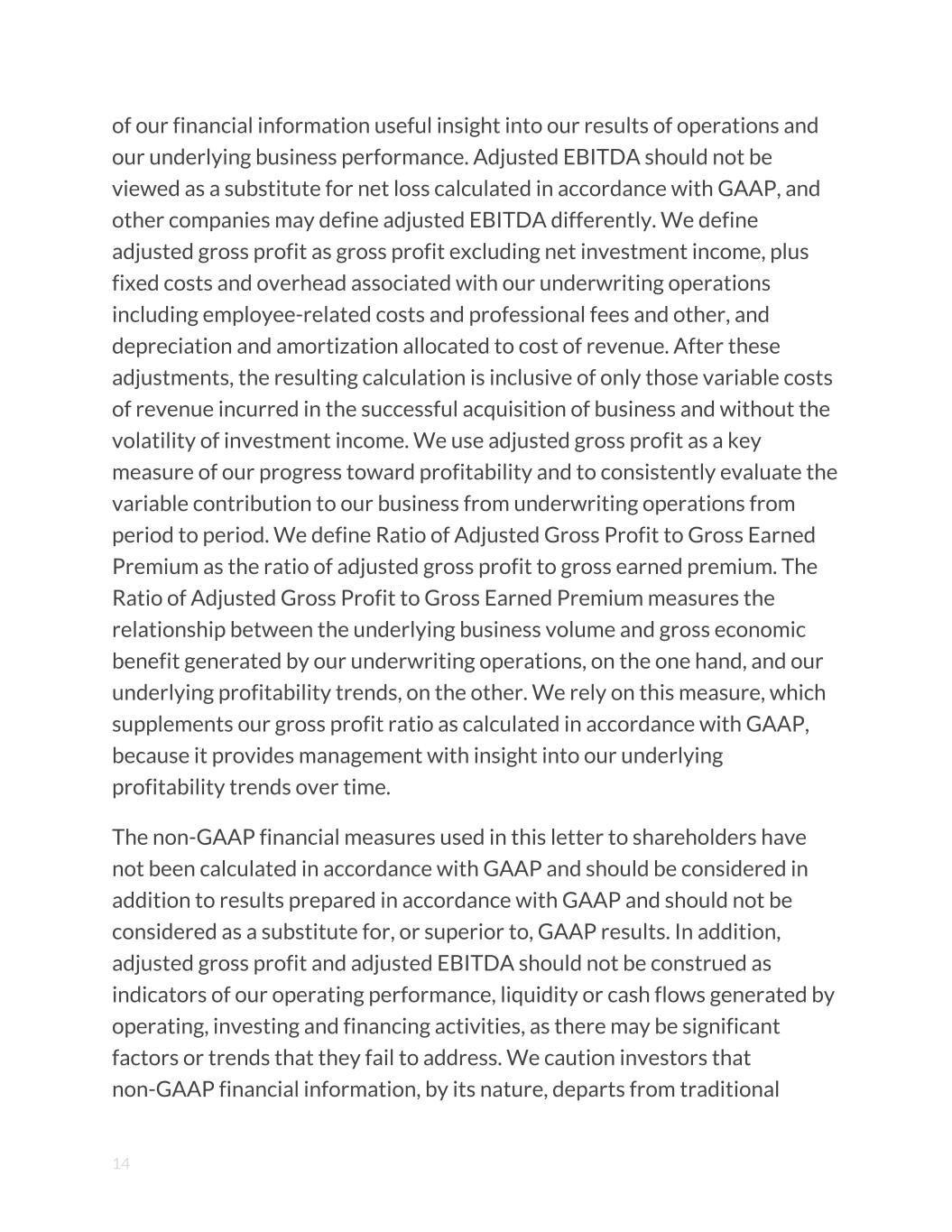
of our financial information useful insight into our results of operations and our underlying business performance. Adjusted EBITDA should not be viewed as a substitute for net loss calculated in accordance with GAAP, and other companies may define adjusted EBITDA differently. We define adjusted gross profit as gross profit excluding net investment income, plus fixed costs and overhead associated with our underwriting operations including employee-related costs and professional fees and other, and depreciation and amortization allocated to cost of revenue. After these adjustments, the resulting calculation is inclusive of only those variable costs of revenue incurred in the successful acquisition of business and without the volatility of investment income. We use adjusted gross profit as a key measure of our progress toward profitability and to consistently evaluate the variable contribution to our business from underwriting operations from period to period. We define Ratio of Adjusted Gross Profit to Gross Earned Premium as the ratio of adjusted gross profit to gross earned premium. The Ratio of Adjusted Gross Profit to Gross Earned Premium measures the relationship between the underlying business volume and gross economic benefit generated by our underwriting operations, on the one hand, and our underlying profitability trends, on the other. We rely on this measure, which supplements our gross profit ratio as calculated in accordance with GAAP, because it provides management with insight into our underlying profitability trends over time. The non-GAAP financial measures used in this letter to shareholders have not been calculated in accordance with GAAP and should be considered in addition to results prepared in accordance with GAAP and should not be considered as a substitute for, or superior to, GAAP results. In addition, adjusted gross profit and adjusted EBITDA should not be construed as indicators of our operating performance, liquidity or cash flows generated by operating, investing and financing activities, as there may be significant factors or trends that they fail to address. We caution investors that non-GAAP financial information, by its nature, departs from traditional 14

accounting conventions. Therefore, its use can make it difficult to compare our current results with our results from other reporting periods and with the results of other companies. Our management uses these non-GAAP financial measures, in conjunction with GAAP financial measures, as an integral part of managing our business and to, among other things: (i) monitor and evaluate the performance of our business operations and financial performance; (ii) facilitate internal comparisons of the historical operating performance of our business operations; (iii) facilitate external comparisons of the results of our overall business to the historical operating performance of other companies that may have different capital structures and debt levels; (iv) review and assess the operating performance of our management team; (v) analyze and evaluate financial and strategic planning decisions regarding future operating investments; and (vi) plan for and prepare future annual operating budgets and determine appropriate levels of operating investments. Investors are encouraged to review the reconciliation of these non-GAAP financial measures to their most directly comparable GAAP financial measures as provided in the tables accompanying this letter to shareholders. This letter to shareholders also includes key performance indicators, including customers, in force premium, premium per customer, gross earned premium, gross loss ratio and net loss ratio. We define customers as the number of current policyholders underwritten by us or placed by us with third-party insurance partners (who pay us recurring commissions) as of the period end date. A customer that has more than one policy counts as a single Customer for the purposes of this metric. We view customers as an important metric to assess our financial performance because customer growth drives our revenue, expands brand awareness, deepens our market penetration, creates additional upsell and 15

cross-sell opportunities and generates additional data to continue to improve the functioning of our platform. We define in force premium ("IFP") as the aggregate annualized premium for customers as of the period end date. At each period end date, we calculate IFP as the sum of: (i) In force written premium — the annualized premium of in force policies underwritten by us; and (ii) In force placed premium — the annualized premium of in force policies placed with third party insurance companies for which we earn a recurring commission payment. In force placed premium currently reflects less than 1% of IFP. The annualized value of premiums is a legal and contractual determination made by assessing the contractual terms with our customers. The annualized value of contracts is not determined by reference to historical revenues, deferred revenues or any other GAAP financial measure over any period. IFP is not a forecast of future revenues nor is it a reliable indicator of revenue expected to be earned in any given period. We believe that our calculation of IFP is useful to analysts and investors because it captures the impact of growth in customers and premium per customer at the end of each reported period, without adjusting for known or projected policy updates, cancellations, rescissions and non-renewals. We use IFP because we believe it gives our management useful insight into the total reach of our platform by showing all in force policies underwritten and placed by us. Other companies, including companies in our industry, may calculate IFP differently or not at all, which reduces the usefulness of IFP as a tool for comparison. We define premium per customer as the average annualized premium customers pay for products underwritten by us or placed by us with third-party insurance partners. We calculate premium per customer by dividing IFP by customers. We view premium per customer as an important metric to assess our financial performance because premium per customer reflects the average amount of money our customers spend on our products, which helps drive strategic initiatives. 16

Gross earned premium is the earned portion of our gross written premium. We use this operating metric as we believe it gives our management and other users of our financial information useful insight into the gross economic benefit generated by our business operations and allows us to evaluate our underwriting performance without regard to changes in our underlying reinsurance structure. Unlike net earned premium, gross earned premium excludes the impact of premiums ceded to reinsurers, and therefore should not be used as a substitute for net earned premium, total revenue, or any other measure presented in accordance with GAAP. We define gross loss ratio, expressed as a percentage, as the ratio of losses and loss adjustment expense to gross earned premium. We define net loss ratio, expressed as a percentage, as the ratio of losses and loss adjustment expense, less amounts ceded to reinsurers, to net earned premium. Links The information contained on, or that can be accessed through, hyperlinks included herein is deemed not to be incorporated in or part of this shareholder letter. Earnings teleconference information The Company will discuss its fourth quarter and full year 2020 financial results during a teleconference on March 2, 2021, at 8:00 AM ET. The conference call can be accessed in the U.S. at (866) 270-1533 or outside the U.S. at (412) 317-0797 with the conference ID: 1015 2291. 17

A live audio webcast of the call will also be available simultaneously at https://investor.lemonade.com Following completion of the call, a recorded replay of the webcast will be available on the investor relations section of Lemonade’s website. Additional investor information can be accessed at https://investor.lemonade.com About Lemonade Lemonade offers renters, homeowners, pet, and life insurance. Powered by artificial intelligence and behavioral economics, Lemonade’s full stack insurance carriers in the US and the EU replace brokers and bureaucracy with bots and machine learning, aiming for zero paperwork and instant everything. A Certified B-Corp, Lemonade gives unused premiums to nonprofits selected by its community, during its annual Giveback. Lemonade is currently available in the United States, Germany, the Netherlands, and France, and continues to expand globally. For more information, please visit www.lemonade.com, and follow Lemonade on Twitter or Instagram. Media inquiries: press@lemonade.com Investor contact: ir@lemonade.com Forward-looking statement safe harbor This letter to shareholders contains forward-looking statements within the meaning of the Private Securities Litigation Reform Act of 1995. All statements contained in this letter to shareholders that do not relate to matters of historical fact should be considered forward-looking statements, 18

including statements regarding our anticipated financial performance, including our financial outlook for the first quarter of 2021 and the full year 2021, our industry, business strategy, plans, goals and expectations concerning our market position, future operations and other financial and operating information. These statements are neither promises nor guarantees, but involve known and unknown risks, uncertainties and other important factors that may cause our actual results, performance or achievements to be materially different from any future results, performance or achievements expressed or implied by the forward-looking statements, including, but not limited to, the following: Our history of losses and the fact that we may not achieve or maintain profitability in the future; our ability to retain and expand our customer base; the fact that the “Lemonade” brand may not become as widely known as incumbents’ brands or the brand may become tarnished; the denial of claims or our failure to accurately and timely pay claims; our ability to attain greater value from each user; the novelty of our business model and its unpredictable efficacy and susceptibility to unintended consequences; the possibility that we could be forced to modify or eliminate our Giveback, which could undermine our business model; the examinations and other targeted investigations by our primary and other state insurance regulators that could result in adverse examination findings and necessitate remedial actions; our limited operating history; our ability to manage our growth effectively; the impact of intense competition in the segments of the insurance industry in which we operate on our ability to attain or increase profitability; the unavailability of reinsurance at current levels and prices, which could limit our ability to write new business; our ability to renew reinsurance contracts on comparable duration and terms to those currently in effect; our exposure to counterparty risks as a result of reinsurance; the loss of personal customer information, damage to our reputation and brand, or harm to our business 19
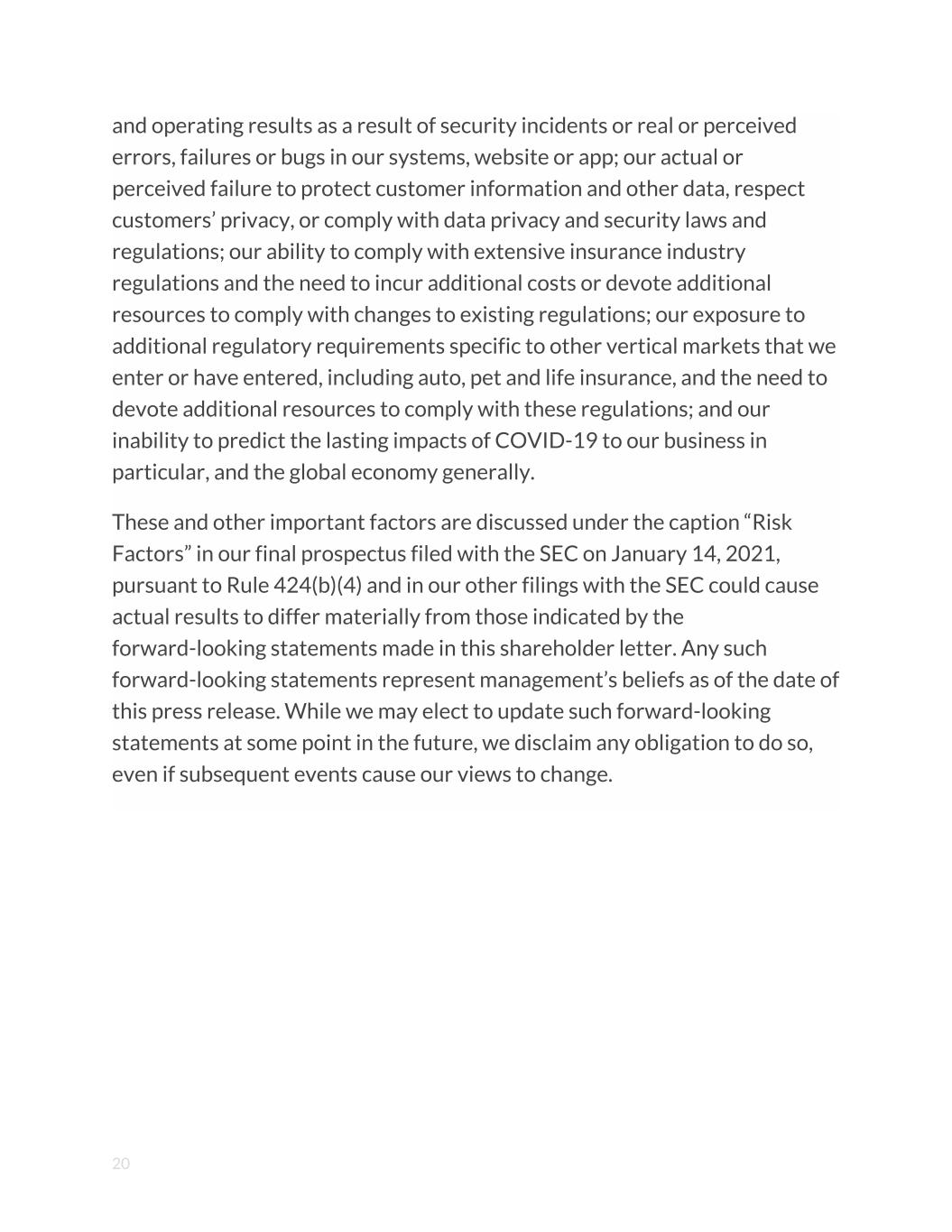
and operating results as a result of security incidents or real or perceived errors, failures or bugs in our systems, website or app; our actual or perceived failure to protect customer information and other data, respect customers’ privacy, or comply with data privacy and security laws and regulations; our ability to comply with extensive insurance industry regulations and the need to incur additional costs or devote additional resources to comply with changes to existing regulations; our exposure to additional regulatory requirements specific to other vertical markets that we enter or have entered, including auto, pet and life insurance, and the need to devote additional resources to comply with these regulations; and our inability to predict the lasting impacts of COVID-19 to our business in particular, and the global economy generally. These and other important factors are discussed under the caption “Risk Factors” in our final prospectus filed with the SEC on January 14, 2021, pursuant to Rule 424(b)(4) and in our other filings with the SEC could cause actual results to differ materially from those indicated by the forward-looking statements made in this shareholder letter. Any such forward-looking statements represent management’s beliefs as of the date of this press release. While we may elect to update such forward-looking statements at some point in the future, we disclaim any obligation to do so, even if subsequent events cause our views to change. 20

Condensed Consolidated Statements of Operations and Comprehensive Loss $ in millions, except per share amounts, unaudited 21
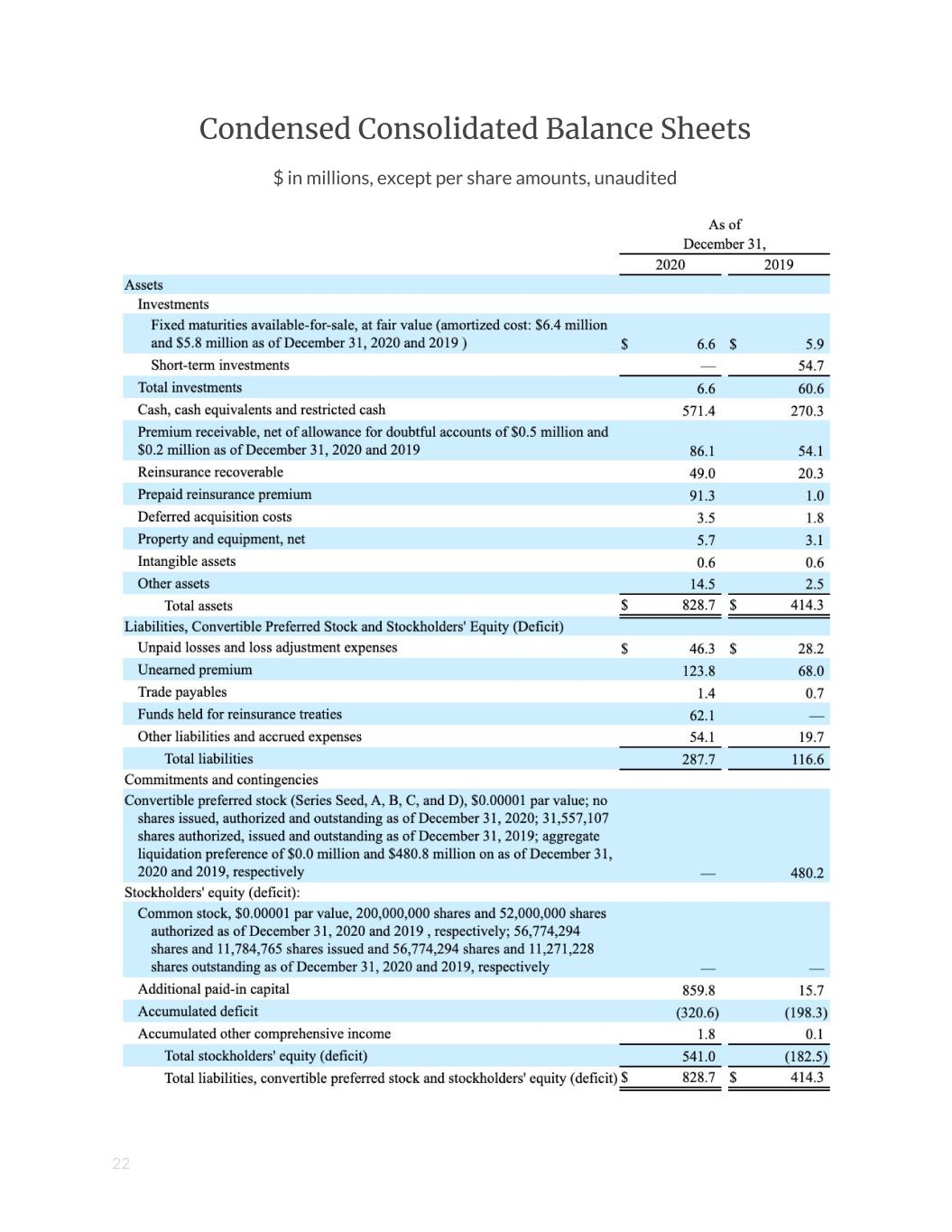
Condensed Consolidated Balance Sheets $ in millions, except per share amounts, unaudited 22

Condensed Consolidated Statements of Cash Flows $ in millions, unaudited 23

Reconciliation of Non-GAAP Financial Measures to their Most Directly Comparable GAAP Financial Measures $ in millions, except for per share information, unaudited Adjusted Gross Profit and Adjusted Gross Profit Margin The following table provides a reconciliation of total revenue to adjusted gross profit and the related adjusted gross profit margin for the periods presented: 24

Ratio of Adjusted Gross Profit to Gross Earned Premium The following table sets forth our calculation of the Ratio of Adjusted Gross Profit to Gross Earned Premium for the periods presented: Adjusted EBITDA The following table provides a reconciliation of adjusted EBITDA to net loss for the periods presented: 25
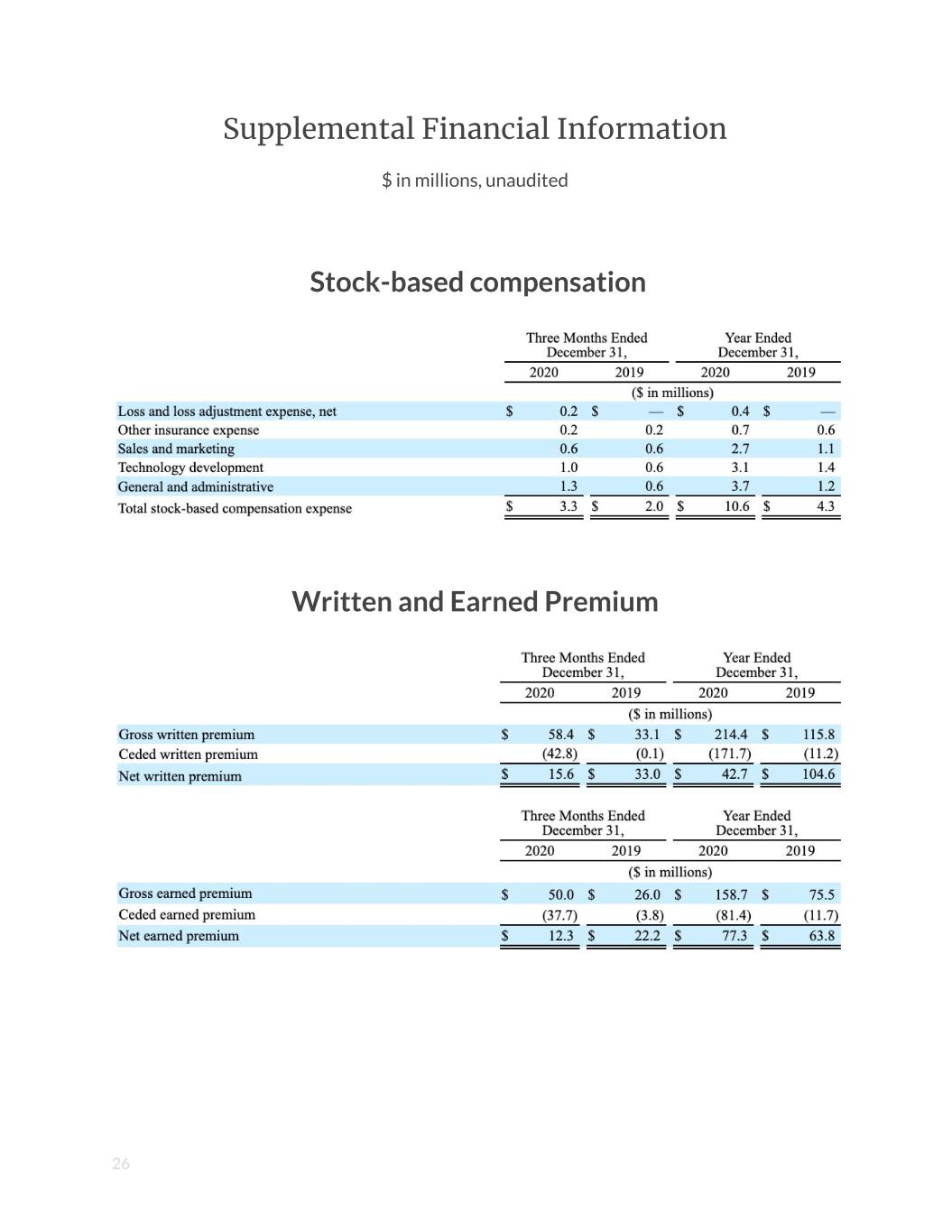
Supplemental Financial Information $ in millions, unaudited Stock-based compensation Written and Earned Premium 26

Historical Operating Metrics 27

Appendix to the Q4 2020 Shareholder Letter
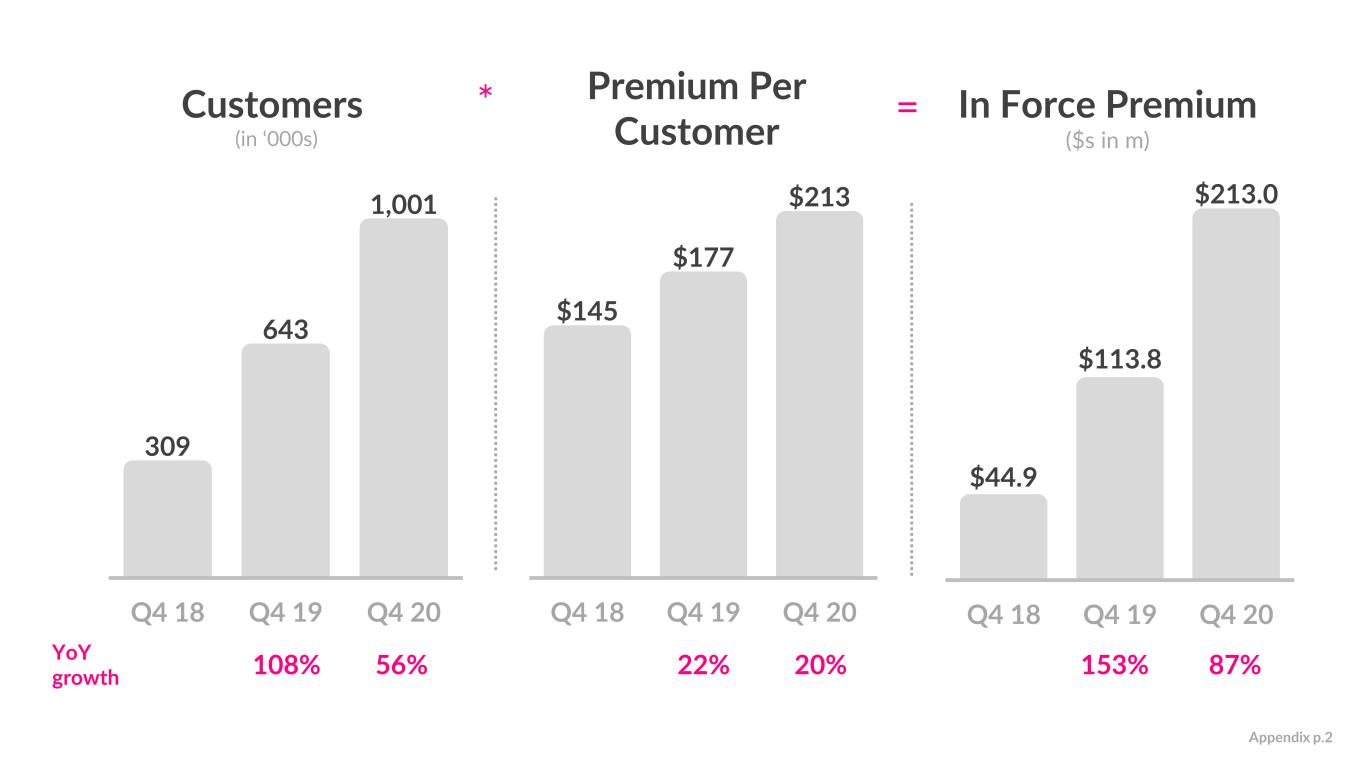
Customers (in ‘000s) In Force Premium ($s in m) 56% 108% YoY growth 87%153% 309 643 1,001 Q4 18 Q4 19 Q4 20 $44.9 $113.8 $213.0 Q4 18 Q4 19 Q4 20 $145 $177 $213 Q4 18 Q4 19 Q4 20 Premium Per Customer 20% 22% * = Appendix p.2

Gross Earned Premium (“GEP”) ($s in m) Revenue (1) ($s in m) $9.0 $23.5 $20.5 Q4 18 Q4 19 Q4 20 (13%)161% YoY growth $10.1 $26.0 $50.0 Q4 18 Q4 19 Q4 20 92% 157% (1) Our ‘proportional reinsurance’ agreements went into effect at the beginning of Q3 20, increasing the proportion of premium that is ceded. This drives the YoY decline in revenue. Appendix p.3

Loss Ratio (2) 87% 82% 78% 73% 72% 67% 72% 73% 75% 74% 71% 69% 72% 70% 65% 76% Q1 19 Q2 19 Q3 19 Q4 19 Q1 20 Q2 20 Q3 20 Q4 20 Gross Loss Ratio (3) Net Loss Ratio (3) (2) Q4 20 relationship between loss ratios is primarily driven by the unallocated portion of loss adjustment expense, which is not subject to our reinsurance program. (3) We define gross loss ratio, expressed as a percentage, as the ratio of losses and loss adjustment expense to gross earned premium, and net loss ratio, expressed as a percentage, as the ratio of losses and loss adjustment expense, less amounts ceded to reinsurers, to net earned premium. Appendix p.4
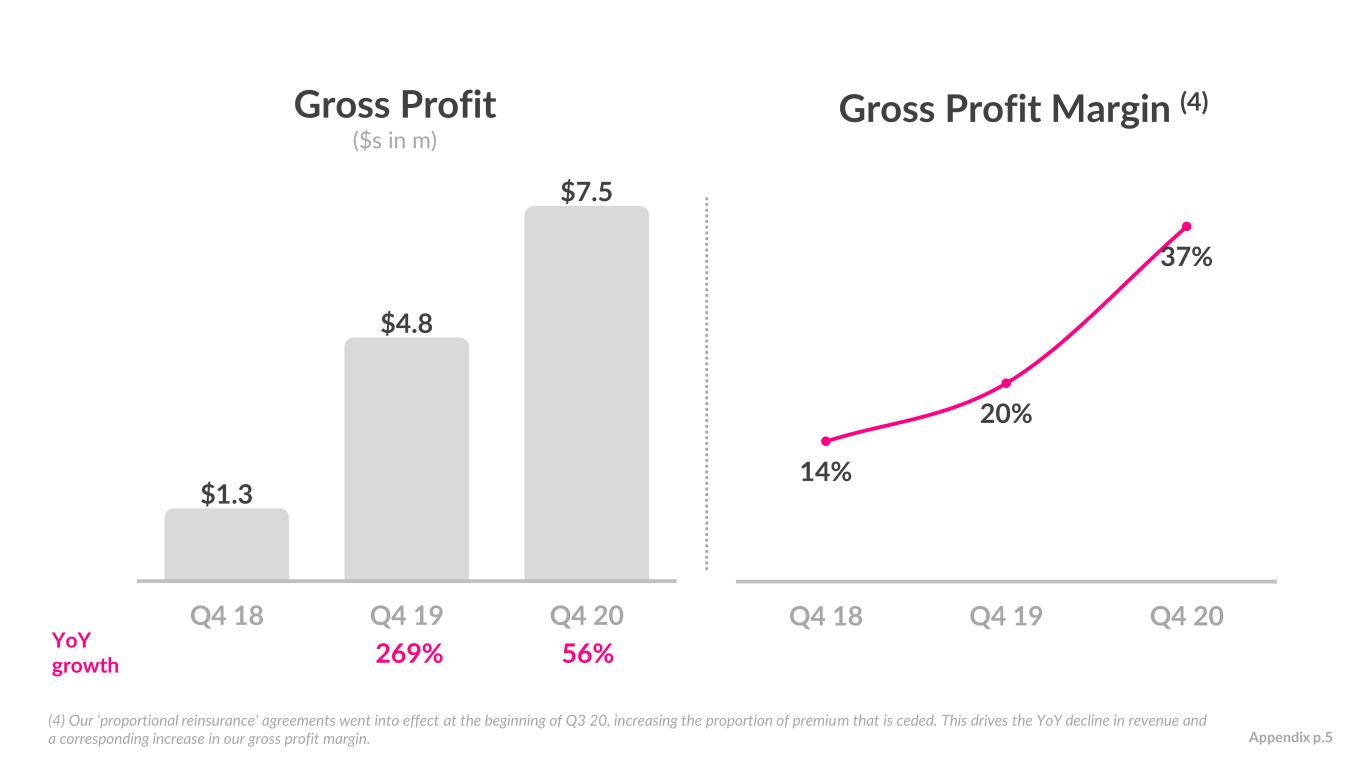
Gross Profit ($s in m) Gross Profit Margin (4) 56% 269% 14% 20% 37% Q4 18 Q4 19 Q4 20 YoY growth Appendix p.5 (4) Our ‘proportional reinsurance’ agreements went into effect at the beginning of Q3 20, increasing the proportion of premium that is ceded. This drives the YoY decline in revenue and a corresponding increase in our gross profit margin. $1.3 $4.8 $7.5 Q4 18 Q4 19 Q4 20

Adj. Gross Profit (5) ($s in m) Ratio of Adj. Gross Profit to GEP $1.6 $5.1 $9.5 Q4 18 Q4 19 Q4 20 86% 219% (5) This is a non-GAAP metric. For a description of these metrics and a reconciliation to the most directly comparable GAAP measure, please see "Reconciliation of Non-GAAP Financial Measures to GAAP" and "Non-GAAP financial measures and key operating metrics". Specifically for Q4 18, the most comparable GAAP metric of Gross Profit was $1.3m; adjustments to Adj. Gross Profit are net investment income of ($0.5m), employee-related expense of $0.4m, professional fees and other expense of $0.4m. 16% 20% 19% Q4 18 Q4 19 Q4 20 YoY growth Appendix p.6
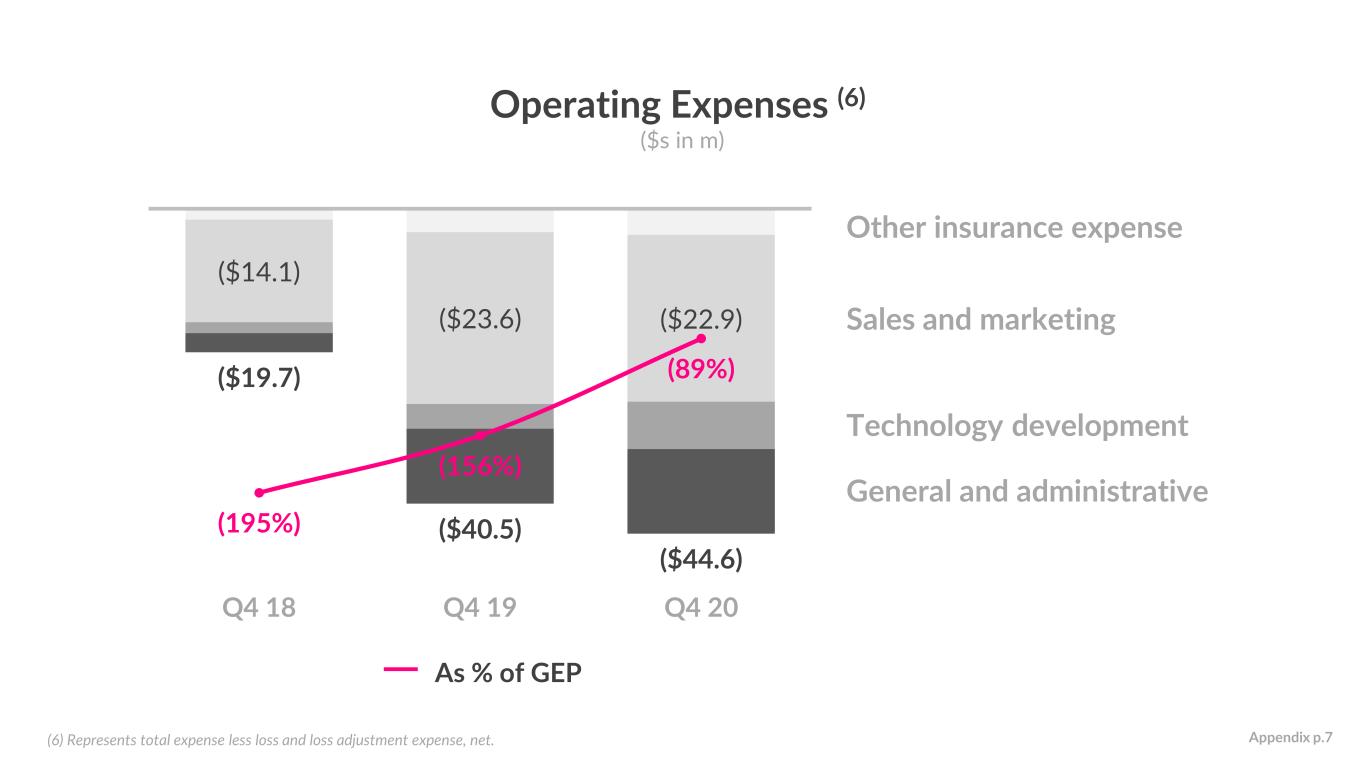
($14.1) ($23.6) ($22.9) ($19.7) ($40.5) ($44.6) (195%) (156%) (89%) Q4 18 Q4 19 Q4 20 Other insurance expense Sales and marketing Technology development General and administrative Operating Expenses (6) ($s in m) (6) Represents total expense less loss and loss adjustment expense, net. Appendix p.7 As % of GEP

Net Loss ($s in m) Adj. EBITDA (7) ($s in m) 5%(87%) YoY growth (4%) (93%) (7) This is a non-GAAP metric. For a description of these metrics and a reconciliation to the most directly comparable GAAP measure, please see "Reconciliation of Non-GAAP Financial Measures to GAAP" and "Non-GAAP financial measures and key operating metrics". Specifically for Q4 18, the most comparable GAAP metric of Net Loss was ($16.9m); adjustments to Adj. EBITDA are stock-based compensation expense of $0.6m and net investment income expense of ($0.5m). Appendix p.8 ($16.9) ($32.7) ($33.9) Q4 18 Q4 19 Q4 20 ($16.8) ($31.4) ($29.7) Q4 18 Q4 19 Q4 20

Guidance ($s in m) Q1 2021 Full Year 2021 $241.0 $246.0 $53.5 $54.5 $21.5 $22.5 ($43.0) ($40.0) ($173) ($163) $114 $117 $270 $275 $372 $378 Low High Low High In Force Premium (as of end of period) Gross Earned Premium Revenue Adj. EBITDA (8) (8) Adj. EBITDA is a non-GAAP metric. A full reconciliation of Adj. EBITDA guidance to net loss on a forward-looking basis cannot be provided without unreasonable efforts, as we are unable to provide reconciling information with respect to income tax expense, depreciation and amortization, interest income, net investment income, and other transactions that we consider to be unique in nature. We estimate stock-based compensation for the first quarter and full year 2021 is approximately $5m and $25m, respectively. Appendix p.9



































